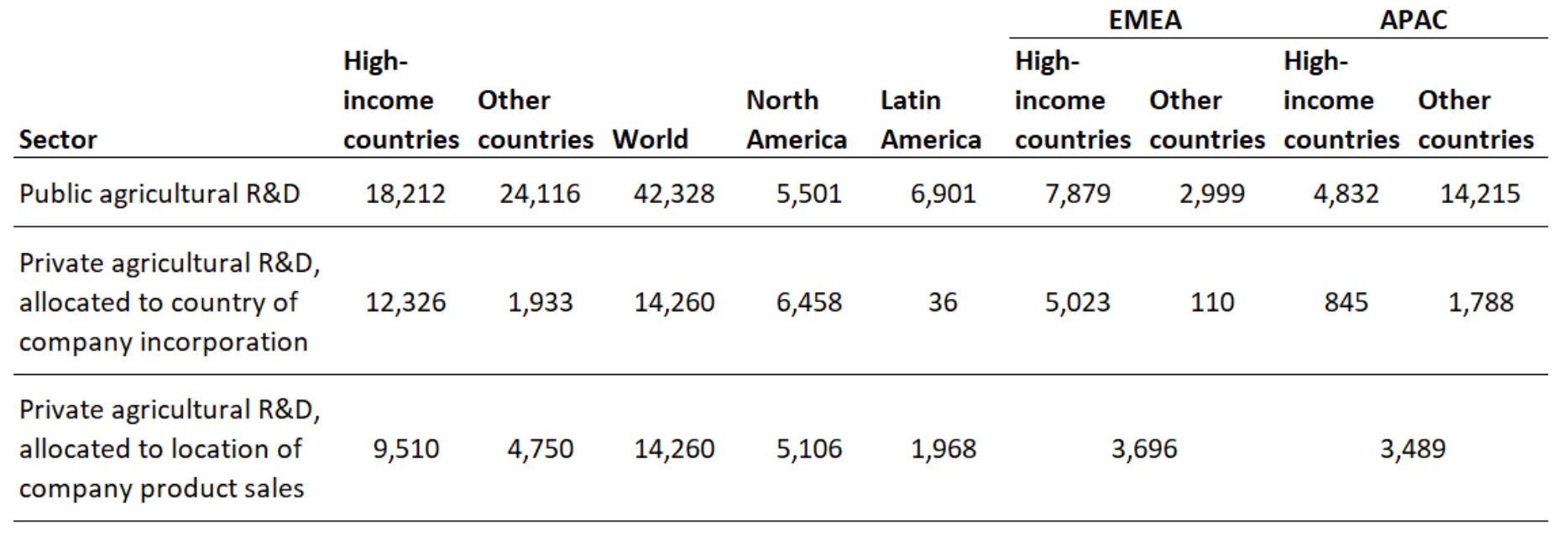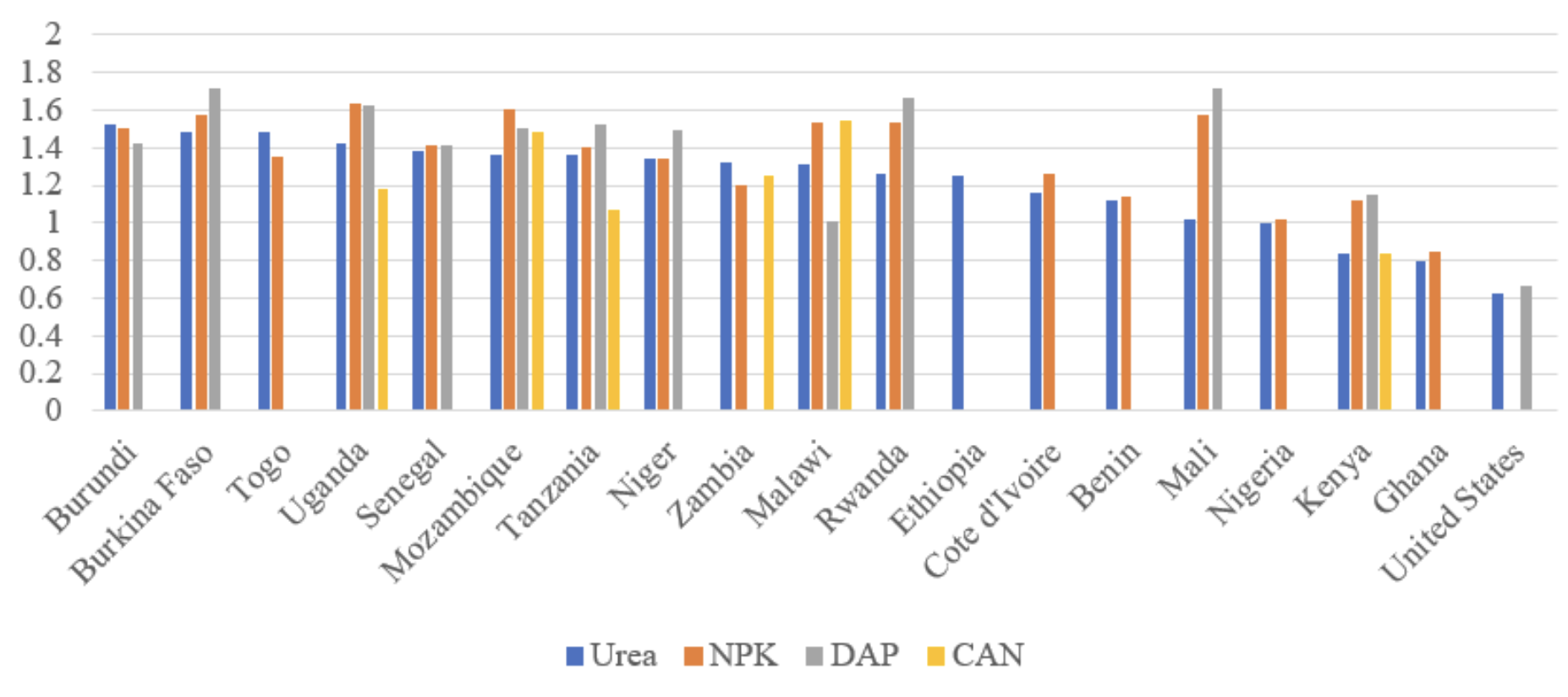
Given what we know to date about the stagnation of both agricultural technology use and agricultural productivity in Africa, what policy actions might be appropriate?
Investments in technology for agriculture
There is a need for more and longer-term investments in research and development for agricultural technologies themselves in Africa. Total spending per farmer on R&D for agriculture in Africa is two orders of magnitude lower than in developed countries. The United Nations Food and Agriculture Organization, based on data from ASTI (IFPRI), estimates that spending per farmer on R&D across Africa has been about $50 (in US dollars at purchasing power parity) or less since 1990.[1] For comparison, R&D spending per farmer in Brazil was about $1200 in 2000 and has more than doubled since then.
Across regions of Africa, one can see substantial increases in Southern Africa and East Africa, where R&D spending per farmer has recently climbed substantially to nearly $250 and almost $150, respectively. But these changes make the average R&D spending per farmer for Central, North, and West Africa, hovering at less than $25, look even lower. Countries like Uganda, Zimbabwe, Niger, Burundi, and Ethiopia had growth in public agricultural R&D spending at annual rates of 6% or more from 2000-2014, according to data from CGIAR ASTI. Conversely, countries like Togo, Gabon, and Guinea averaged annual declines of 4% or more in public agricultural R&D spending over that time frame.
In short, the lack of productive new agricultural technologies ready to be adopted in Africa is no mystery; it is the result of low levels of agricultural R&D investment in the past.[2] In addition, volatility in already low levels of investments make the problem worse. Rawat (2020) shows for public investment in R&D, the volatility in these expenditures is highest in sub-Saharan Africa (and lowest in South Asia).
Although private R&D in agriculture has grown tremendously over the last 20-odd years and is expected to play a stronger role in the future (Fuglie 2016), it still comprises only a quarter of overall agricultural R&D. Moreover, almost all private agricultural R&D is in (and for) the developed world, as illustrated in Figure 7 below (Heisey and Fuglie 2018).
Figure 7: Public and private agricultural R&D spending by region, 2011 (US$M PPP)

Agricultural research and development is a process that builds on itself. For example, in South Asia after the introduction of the initial “green revolution” varieties of rice, Evenson and Gollin (2003) show that a sustained R&D effort lead to multiple generations of new varieties characterised by gradually increased yields, improved agronomic performance and nutritional content, and increased resistance to pests. In India, 20-40 new varieties of rice have commonly been released annually since 1970, along with 10-20 new varieties of both maize and wheat, as reported by the Indian Council of Agricultural Research (ICAR) - Indian Institute of Maize Research (IIMR). In addition, the numbers of new varieties introduced has risen in recent years (as shown in SeedNet India Portal). In contrast, in Kenya where maize is the main staple, it was common to have five or fewer new varieties introduced annually from 1970 to 2000, although since then the number of new varieties of maize being introduced has risen to Indian levels, according to data from the Kenya Plant Health Inspectorate Service (KEPHIS). Of course, what matters is not just the number of varieties but the quality or yield improvement provided by these varieties. As Karanja (1996) highlights for the earlier research and development efforts in Kenya, research yields were exhibiting a “plateau effect”, with newly released varieties in 1989 having smaller yield advantages over their predecessors than previously released ones. However, Bird et al. (2022) show that locally-adapted maize varieties have important yield and revenue effects in Kenya, both for wealthier and poorer farmers. In addition, much of Africa relies on staples other than rice, wheat, or maize. Internationally-funded research in other staples such as millet, sorghum, or cassava began decades later, in the 1980s rather than the 1960s. Present-day yield gains from HYVs in roots, tubers, and pulses have been a fraction of those in cereals, aligning with the additional decades of R&D benefiting cereals (Gollin et al. 2021).
Broad or customisable technology
The substantial heterogeneity experienced by most African farmers can be addressed in two ways. One approach is that a combination of irrigation, permanent cultivation, and terrain engineering can reduce local differences. The other is to seek new technologies that are more customisable or that can be profitable across a wider range of circumstances.
In developed countries, there is much more customisation of new agricultural technologies to very local circumstances than there is in Africa. More than 60 years ago, Griliches (1957) was showing how new technologies were adapted to local conditions in US agriculture. It has long been common for farmers in developed country agriculture who are separated by only a few dozen miles and facing almost uniform input and output prices to prefer different seed varieties for major grains. Hurley et al. (2004) show within single farm plots in the American state of Minnesota, optimal fertiliser doses can vary by a factor of two. Recently, this customisation of technology to (relatively) small variations in growing conditions, even within a single plot, has intensified in high-income countries with the growth of precision agriculture (for example, Stoorvogel et al. 2015, Schimmelpfennig 2016, North Dakota State University undated).
Agricultural research efforts in most of Africa have been less successful in adapting technology to local variation. In most of Africa, only extremely limited customisation of modern varieties of seed is available. In agronomic trials in northern Ghana, for example, the best performing maize seed was a variety developed for South African conditions (van Asselt et al. 2020). Fertiliser recommendations to African farmers are often uniform over large areas of highly variable soils (Michelson et al. 2021). Scale economies must be important here. Small and spread out farms make sending out different extension agents with different messages costly.
Developing, testing, and adopting new technologies in this environment poses significant challenges. Customisation requires much better feedback from a much larger and more diverse set of farmers. One promising direction is greatly expanded use of farmer participatory trials to map heterogeneity and optimise recommendations. A related approach would use the rapid expansion of information network availability across Africa to carry out on-farm trials of new technologies at a much larger scale than has been possible in the past (Newman et al. 2012). For example, Precision Development (PxD) is building low-cost information systems to reach smallholder farmers with personalised advice through their mobile phones (Cole and Fernando 2021) and now reaches over 5.7 million farmers in ten countries. Cole and Fernando (2021) find that farmers are willing to pay $2 for a nine-month subscription to the service, which could be a viable business model if it is expanded. A first step in harnessing these opportunities is building up the base of relevant local information regarding what technologies are viable for testing in what local areas of each country.
One obstacle to this approach is the low number of agricultural research stations and the historically low numbers of staff and high turnover at these stations (Lipton 1988) across countries in Africa. The United States has 607 research stations (Pearson and Atucha 2015); based on data on farmers from USDA (2021), this constitutes about 134 research stations per 100,000 farmers. For comparison, we looked at data on the number of research stations in some African countries from Beye (2002) along with data on farmers from about 2002 from the Agricultural Science and Technology Indicators (ASTI) published by CGIAR. Ghana has only 14 agricultural research stations (0.28 per 100,000 farmers); Malawi only 154 (0.34 per 100,000 farmers); Mali has seven (1.02 per 100,000 farmers); Madagascar has 24 (0.42 per 100,000 farmers); Kenya has 25 (0.22 per 100,000 farmers); Cameroon has 30 (0.79 per 100,000 farmers); and Senegal has 30 (0.94 per 100,000 farmers). Tests of new varieties by the existing network of African research stations cannot provide the necessary local information on returns to varieties that farmers need, which in turn can help to explain the large differences in returns between station trials and on-farm trials that are often observed (Laajaj et al. 2020).
We also do not know enough about what seed varieties are actually used by African farmers. Recent work on DNA fingerprinting finds discrepancies between self-reports of what farmers say they are using and the DNA results (Wossen et al. 2019a, 2019b, Poets et al. 2020). Clearly, we need a significant investment push to generate fine-scale information on what technologies are used and the returns to those technologies.
In that vein, large-scale participatory trials of new technologies could provide a foundation for a broader process of integrating “citizen science” into agricultural R&D and extension. As discussed earlier, the same information technology that would permit the communication of trial protocols and results between scientists and participants is already being used to provide inexpensive, timely information and advice to farmers. It could also provide a forum for generating new ideas for trials and for crowd-sourcing farmer input into research investment decisions (for example, Cole and Fernando 2021). Inducing increased private investment into agricultural technologies appropriate for small farmers requires new policy instruments (Barrett 2023).
Cheaper inputs
Many African farmers face extremely high fertiliser prices. Over 60% of the fertiliser in Africa was imported in 2016 (see the Africa Fertiliser Market Development Report 2018) and this, along with extremely high transport costs and low population density on the continent, implies many farmers often face high fertiliser prices, which makes fertiliser unprofitable for them as a technology. For example, fertiliser prices in some African countries (see Cedrez et al. 2020) can be twice as high as in the US (see Figure 8). Additionally, major shocks such as the Russian invasion of Ukraine, which caused fertiliser prices to more than double, can make the price of fertiliser volatile (Glauber and Debucquet 2023).
Policy can try to target these costs indirectly in a multitude of ways. First, investing in infrastructure that will lower transports costs not only lowers the prices of inputs but also potentially improved market access for outputs, as lower costs of search and trading lead to improved market integration (Casaburi et al. 2013, Newman et al. 2018, Bergquist et al. 2022). Another alternative would be to encourage more local production of fertiliser or more geographically local trade in fertiliser. As of January 2021, there were only 135 fertiliser plants across all of sub-Saharan Africa (excluding South Africa): 17 are manufacturing plants and 101 are processing plants (IFDC 2021). In some countries, the prices of fertiliser may be high because a small number of importers dominate the market. In these cases, some combination of short-term assistance to entrants or pro-competitive policy interventions may be needed.
Figure 8: Fertiliser prices (USD/kg) across countries in Africa and the US (2016)

Policy can additionally try to target these costs directly in a multitude of ways. One obvious approach would be to subsidise fertiliser, but it is not clear that such subsidies are beneficial in the long term or are a sustainable policy tool to increase adoption and yields (see earlier discussion). In addition, long-term subsidies on nitrogen based fertilisers have sometimes led to systematic (and potentially serious) overuse and, hence, longer term soil fertility issues, as Kishore et al. (2021) document in Bangladesh, India, Nepal and Sri Lanka.
An alternative would be to encourage more local production of fertiliser or more geographically local trade in fertiliser. In some countries, the prices of fertiliser may be high because a small number of importers dominate the market, making it not very competitive. In these cases, some combination of short-term assistance to entrants or pro-competitive policy interventions may be needed.
Supporting other inputs may be useful as well. The earlier discussion noted that although rainfall insurance affects the use of technology, farmers are still largely not willing to pay for it at actuarially fair prices (J-PAL 2016). Subsidies for such insurance could become one of the basic social welfare tools for these economies. Investments in improved weather forecasting could also reduce weather risks more directly. Yegbemey et al. (2023) experimentally evaluate weather forecast services in Benin and show positive effects on labour productivity in maize (but not in cotton).
Conclusion: Pressing questions
When it comes to improving agricultural technology and productivity in Africa, we have learned much about what doesn’t work. While this is valuable, it also makes apparent how much we do not know. We conclude with seven pressing questions to guide future work.
First, how should we provide incentives to either the public or the private sector for the development of new agricultural technologies that are locally customised and how should we provide incentives for experimentation with these technologies? Rao et al. (2019) estimate the returns to agricultural R&D and show that they remain as high as ever (their median estimated internal rate of return is over 40% per year, with no significant time trend). Barrett (2023) proposes “benevolent patent extensions” as a way to induce private sector investment in otherwise-unprofitable R&D to address the challenges faced uniquely by smallholder farmers.
Second, are improvements in agricultural technology and productivity the most useful way to raise the standard of living and create a path out of poverty, or should the focus be on investments in the non-agricultural sector? There is some work showing the tight connections between the agricultural and non-agricultural sectors (for example, Haggblade et al. 2010, Gollin et al. 2021), but it remains an open question whether the most productive policies would seek to change the returns to non-agricultural investments, and in this way draw labour out of agriculture and facilitate structural transformation, or whether direct investment in increasing agricultural productivity should be the focus.
Third, can the integration of rural and urban markets in Africa provide better incentives to farmers? A lot of urban food production comes from imports meaning there may be a role for the demand side and better market integration in driving technology adoption to replace these imports with locally produced goods (for a review, see de Janvry and Sadoulet 2020). Creating market incentives that remunerate quality, especially for high value crops, may be one step towards sparking this demand side (Bernard et al. 2017). But at a more fundamental level, we must seek to analyse relevant markets and incorporate this analysis into our research on technology adoption.
Fourth, there is very little irrigated farmland across Africa. Many farmers in the region use small-scale pump and hand irrigation along streams for market gardens, especially in peri-urban areas. More than half of irrigated land in Liberia, Sierra Leone, Ghana and Nigeria is smallholder informal irrigation, not reliant on fixed infrastructure (Drechsel et al. 2006). The aggregate area covered by this smallholder irrigation remains tiny. There is a dearth of quantitative information on the availability and characteristics of groundwater across sub-Saharan Africa, but the underlying geology appears to be such that the potential for high water yield boreholes for irrigation is not widespread, so there may be important geological constraints (Xu et al. 2019). Population density may also be a major constraint to large infrastructure investments required for surface irrigation. If these constraints are binding in certain areas, is there a way to scale down large-scale infrastructure investments? An example would be the small-scale wet coffee mills that TechnoServe helped cooperatives build across East Africa (IPE 2017).
Fifth, we still know little about the role of the state in agriculture. In particular, there is not much work on crony capitalism in agriculture, or the political economy around how policy priorities or large infrastructure investments are decided specifically in agriculture.
Sixth, there is more to learn about some of the constraints we highlighted above, especially when it comes to labour, land markets and the environment. A number of multifaceted interventions have proven to be cost effective in some settings: for example, One Acre Fund in Kenya and the Niger Economic Inclusion Programme, but much remains to be learned in identifying which constraints affect which farmers.
Finally, there are many studies about how climate change is likely to affect agricultural output in Africa and around the world. But we have relatively little understanding how farmers and entire agricultural systems might adapt to these changes.
References
Barrett C B (2023), “Toward an Applied Microeconomics of Agricultural Development,” Journal of Economic Perspectives, 37(1): 3-28.
Bergquist, L F, C McIntosh and M Startz (2022), “Search Costs, Intermediation, and Trade: Experimental Evidence from Ugandan Agricultural Markets”, Working Paper.
Bernard T, E T Taffesse, and S Dercon (2017), “Pathways to sustained technology adoption: Evidence from rural Ethiopia,” Journal of Development Economics, 127: 215-227.
Beye G (2002), Impact of foreign assistance on institutional development of national agricultural research systems in sub-Saharan Africa, Rome: FAO Research and Technology Paper No. 10.
Bird S S, M R Carter, T J Lybbert, M Mathenge, T Njagi, and E Tjernström (2022), “Filling a Niche? The Maize Productivity Impacts of Adaptive Breeding by a Local Seed Company in Kenya,” Journal of Development Economics, 157: 102885.
Cedrez P, J Chamberlin, R Guo, and D J Hijmans (2020), “Spatial Variation of Fertilizer Prices in Sub-Saharan Africa,” PLoS One, 15(1): e0227764.
Cole S and A N Fernando (2021), “The Value of Advice: Evidence from Mobile Phone-Based Agricultural Extension,” American Economic Journal: Applied Economics, 13(2): 236-268.
Drechsel P, A M Kunze, and F Penning de Vries (2006), “Urban Agriculture and Health Risks,” in R van Veenhuizen (ed.), Cities Farming for the Future: Urban Agriculture for Green and Productive Cities, RUAF Foundation, IDRC, IIRR.
Evenson R E and D Gollin (2003), “Assessing the Impact of the Green Revolution, 1960 to 2000,” Science, 300(5620): 758-762.
Fuglie K (2016), “The growing role of the private sector in agricultural research and development worldwide,” Global Food Security, 10: 29-38.
Glauber J and D Debucquet (2023), “Fertilizer Prices, Food Security, and the Ukraine War,” IFPRI Blog, February 2023.
Gollin D, C Hansen, and M Wingender (2021), “Two Blades of Grass: The Impact of the Green Revolution,” Journal of Political Economy, 129(8): 2344-2384.
Griliches Z (1957), “Hybrid Corn: An Exploration in the Economics of Technological Change,” Econometrica, 25(4): 501-522.
Heisey P W and K O Fuglie (2018), “Public agricultural research spending and future U S agricultural productivity growth: Scenarios for 2010-2050,” U S Department of Agriculture, Economic Research Service Report Number 249.
Hurley T M, J K Hyberg, and J M Lesch (2004), “Timing and Timeliness in the Adoption of Site-Specific Technologies,” Review of Agricultural Economics, 26(2): 204-223.
IFDC (2021), Africa Fertilizer Map Database, International Fertilizer Development Center.
J-PAL (2016), “Market Inefficiencies and the Adoption of Agricultural Technologies in Developing Countries,” J-PAL Policy Brief, Abdul Latif Jameel Poverty Action Lab.
Karanja D D (1996), “An Economic and Institutional Analysis of Maize Research in Kenya,” Michigan State University International Development Working Paper.
Laajaj R, J G Stoorvogel, M P McCullough, and A Maertens (2020), “Soil and Farmer Quality: Experimental Evidence on the Returns to Fertilizer and Seed Adoption,” American Journal of Agricultural Economics, 102(4): 1187-1209.
Lipton M (1988), “The place of agricultural research in the development of sub-Saharan Africa,” World Development, 16(10): 1231-1257.
Michelson H, C Magomba, and A Maertens (2021), “Agricultural Input Supply Chains in Africa: Quality and Market Failures,” Annual Review of Resource Economics, 13: 437-460.
Newman C, J Rand, T Talbot, and F Tarp (2018), “Technology transfers, foreign investment and productivity spillovers,” European Economic Review, 101: 162-187.
Ortiz-Bobea A, T R Ault, C M Carrillo, R G Chambers, and D B Lobell (2021), “Anthropogenic climate change has slowed global agricultural productivity growth,” Nature Climate Change, 11(4): 306-312.
Pearson S and S Atucha (2015), “Research Stations in the United States,” University of Wisconsin-Madison Extension Service Report.
Poets A M, E Fang, M E LeClere, A L Wilder, R J Edwards, and J A Doyle (2020), “Genotyping by sequencing reveals high rates of misclassification of parental lines and cultivar mixtures in maize seed lots,” Scientific Reports, 10(1): 4212.
Rawat R (2020), “Public Agricultural R&D Expenditures: Trends and Challenges,” International Food Policy Research Institute (IFPRI) Discussion Paper.
Rao X, Z Hurley, and K Fuglie (2019), “Intrinsic productivity growth in U S agriculture: A meta-regression analysis,” American Journal of Agricultural Economics, 101(3): 890-914.
Schimmelpfennig D (2016), “Farm Profits and Adoption of Precision Agriculture,” Economic Research Report 217, U S Department of Agriculture, Economic Research Service.
Stoorvogel J J, A M Smaling, and E M Andriesse (2015), “Balancing nutrient flows to achieve agricultural sustainability in Africa,” Outlook on Agriculture, 24(1): 12-19.
USDA (2021), “Number of Farms and Land in Farms,” United States Department of Agriculture, National Agricultural Statistics Service.
van Asselt J A, J R Skevas, J W van Wijk, P F Giller, and J J Oosterhuis (2020), “Variety Trials for Maize in Ghana: Implications for Smallholder Farmers,” Agricultural Systems, 184: 102905.
Wossen T, S Abdoulaye, A Alene, A Haile, M Feleke, and V Manyong (2019a), “Impacts of maize varietal adoption on household food security in Nigeria: A treatment effect approach,” Agricultural Economics, 50(4): 475-486.
Wossen T, S Abdoulaye, A Alene, A Haile, M Feleke, and V Manyong (2019b), “The Impact of Improved Maize Adoption on Welfare and Poverty Reduction in Nigeria,” World Development, 122: 420-435.
Xu, Y, P Seward, C Gaye, L Lin and D O Olago (2019), "Preface: groundwater in sub-Saharan Africa.", Hydrogeology Journal, 27(3): 815-822.
Yegbemey R N, J S Faye, C A Gandonou, and A H Aoudji (2023), “The Role of Weather Forecasts in Agricultural Productivity: Experimental Evidence from Benin,” World Development, 156: 105929.
Contact VoxDev
If you have questions, feedback, or would like more information about this article, please feel free to reach out to the VoxDev team. We’re here to help with any inquiries and to provide further insights on our research and content.




